
Milton Mural

Milton Mural
Sebastian Meyer ’98
Photojournalist / Under Every Yard of Sky
Sebastian Meyer’s book, Under Every Yard of Sky, chronicles life in Iraqi Kurdistan and a personal story of friendship and loss. Sebastian followed the Kurds of Iraq as they rose from their bloody past to hover for a moment in a state of peace before being plunged back into war. He spent six years traveling across the region reporting on Kurdistan’s growing prosperity. Then, in 2014, ISIS kidnapped his closest friend, Kamaran Najm, a charismatic Kurdish photographer. Sebastian had moved to Kurdistan to help Kamaran start Metrography, a photo agency that would train Iraqi photographers and represent them to the international media, and after a few years, their clients’ images appeared in National Geographic, the New York Times, the Washington Post, and Der Spiegel. When Kamaran, more like a brother to Sebastian than a friend, was kidnapped, Sebastian threw himself into the search. Kamaran’s disappearance was featured in a two-part series on NPR in June 2019.
 Irene Li ’08
Irene Li ’08
Cookbook author / Double Awesome Chinese Food: Irresistible and Totally Achievable Recipes from Our Chinese-American Kitchen
Irene Li ’08 and her two siblings, creators of the acclaimed Boston restaurant Mei Mei, have released their first cookbook, Double Awesome Chinese Food: Irresistible and Totally Achievable Recipes from Our Chinese-American Kitchen. Full of recipes that marry traditional Asian ingredients with comforting American classics and seasonal ingredients, Double Awesome Chinese Food delivers the goods. The Chinese-American siblings take the fear factor out of cooking this complex cuisine, infusing it with creativity, playfulness, and ease. To learn more go to meimeiboston.com/cookbook.
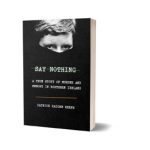 Patrick Radden Keefe ’94
Patrick Radden Keefe ’94
Author / Say Nothing
In December 1972, Jean McConville, a 38-year-old mother of 10, was dragged from her Belfast home by masked intruders, her children clinging to her legs. They never saw her again. Her abduction and murder was one of the most notorious episodes of the vicious period known as the Troubles. Patrick Radden Keefe’s book on the bitter conflict in Northern Ireland and its aftermath uses the McConville case as a starting point for the tale of a society wracked by violent guerrilla war, a war whose consequences have never been reckoned with.
In uncovering and bearing witness to the awful truth of what happened to one woman, Patrick crafts a narrative that stretches to the present day, deftly weaving together a series of indelible characters whose lives were shaped by what happened to McConville with the story of a secret oral history project at Boston College that brought incendiary details about this mystery to light. Based on four years of reporting, Say Nothing is a true-crime tale that sheds new light on a terrible murder, a war story about life and death during the Troubles, a meditation on radical politics and the suffering that people will endure—and inflict—in pursuit of a political ideal, and a vivid portrait of a society unable to shake free
of its own tragic past.
 David Modigliani ’98
David Modigliani ’98
Documentary producer / Running with Beto
Running With Beto follows Democratic candidate Beto O’Rourke’s grassroots, against-all-odds campaign to unseat Texas Senator Ted Cruz. In 2017, Beto was a virtual unknown. As he trekked across all 254 Texas counties attempting to mount a new kind of campaign, he quickly became a national political sensation who was considering a run for president in 2020. David Modigliani ’98, a veteran documentary filmmaker known for showcasing the human side of political stories, spent 12 months embedded with Beto, filmed more than 700 hours of footage, and captured the Democrat as he championed a new way of getting to know a candidate. Understanding that this was an everyday guy making himself vulnerable in an attempt to effect real change, David knew Beto’s story had the power to do so. He was inside every aspect of the campaign, honed in on the stories of local Texans, and captured Beto and his family as they worked to convert long-standing conservatives in one of the most conservative states in the nation.
Waldo Forbes ’60
Author / A Tree in the Woods: Plato and the Ematomic Dilemma
The eminent American philosopher Wilfrid Sellars once described the aim of philosophy as being to understand how things hang together (abbreviated paraphrase). In this short work, Waldo provides two independent premises to draw a line between what might someday be explained (following from premises) and what can currently (and most likely) only be described, hence foundational. He suggests that both his premises are self-evident, albeit unconventional, with one that describes observers and the other, the observed.
 Adrienne Brodeur ’83
Adrienne Brodeur ’83
Author / Wild Game: My Mother, Her Lover, and Me
On a hot August night on Cape Cod when Adrienne Brodeur ’83 was 14, her mother, Malabar, woke her at midnight with five simple words that would set the course of both their lives for years to come: “Ben Souther just kissed me.”
Adrienne instantly became her mother’s confidante and helpmate, blossoming in the sudden light of her attention, and from then on, Malabar came to rely on her daughter to help orchestrate what would become an epic affair with her husband’s closest friend. The affair would have calamitous consequences for everyone involved, impacting Adrienne’s life in profound ways, driving her into a precarious marriage of her own and then into a deep depression. Only years later did she find the strength to embrace her life—and her mother—on her own terms.
Wild Game is a memoir about how the people close to us can break our hearts simply because they have access to them, and the lies we tell in order to justify the choices we make. It’s a story of resilience, a reminder that we need not be the parents our parents were to us. It is scheduled to be released on October 15, 2019.
 Sally (Warburg) Bliumis-Dunn ’77
Sally (Warburg) Bliumis-Dunn ’77
Author / Echolocation
Poet Chard deNiord writes, “Sally Bliumis-Dunn ’77 leaves the reader of Echolocation in deceptively complex verbal landscapes in which both literal and figurative language play off each other with spare yet lapidary results in poems that focus on such everyday subjects as family, animals, loss, the seasons, menopause, and disaster with a compassionate, distilling eye. The voice that emanates from these poems is quiet but deeply resonant with generous stirrings beneath. She writes with what John Keats has called ‘disinterestedness’—a clear-headed objectivity that combines lucid narrative with lyrical charge.”
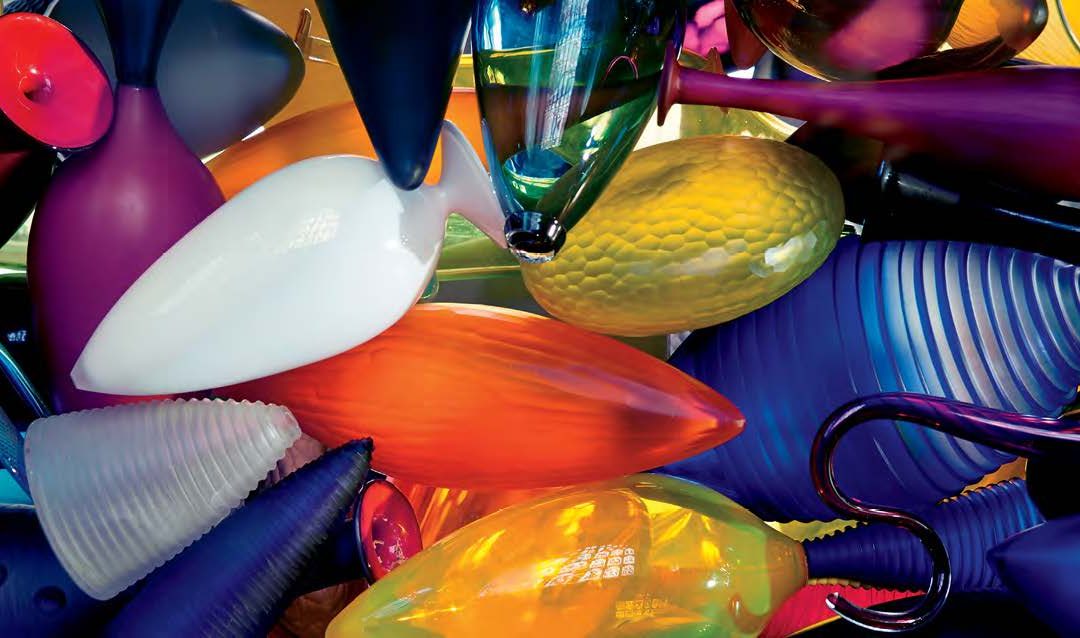
Under an Equal Sky: Baldwin and Guggisberg at Canterbury Cathedral
One hundred elegant, clear glass vessels—amphorae—are suspended from the towering nave of the Canterbury Cathedral, where together they form the shape of a visionary ship, flowing elegantly from stern to prow. The Boat of Remembrance is one of 10 works in an exhibition created by Philip Baldwin ’66 and his wife, Monica Guggisberg.
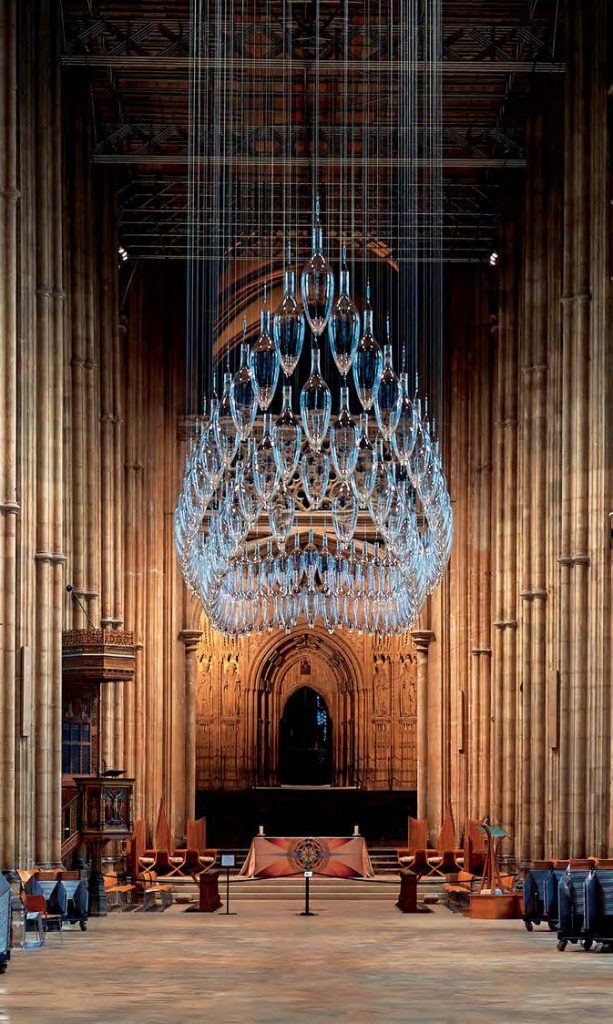 Each year, Canterbury Cathedral memorializes the murder, in 1170, of its sainted archbishop, Thomas Becket. Becket’s death transformed the Cathedral into a focus of pilgrimage for people worldwide. From May 6, 2018, through January 6, 2019, Philip and Monica’s exhibition, “Under an Equal Sky,” celebrated not only the 848 years since the archbishop’s death, but also the 100 years since the armistice of 1918. Philip and Monica are glassblowers who learned their craft in Sweden and have worked as a team since 1980, in Sweden, Switzerland, France and now rural Wales. Their installation embraces a scope of ideas as relevant today as in the 12th century. It recognizes our endemic experience with warfare and its consequences, and acknowledges the mighty flow of human migration, the pilgrimage to escape violence or environmental disasters, the homelessness of millions of migrants and refugees, so many of them children.
Each year, Canterbury Cathedral memorializes the murder, in 1170, of its sainted archbishop, Thomas Becket. Becket’s death transformed the Cathedral into a focus of pilgrimage for people worldwide. From May 6, 2018, through January 6, 2019, Philip and Monica’s exhibition, “Under an Equal Sky,” celebrated not only the 848 years since the archbishop’s death, but also the 100 years since the armistice of 1918. Philip and Monica are glassblowers who learned their craft in Sweden and have worked as a team since 1980, in Sweden, Switzerland, France and now rural Wales. Their installation embraces a scope of ideas as relevant today as in the 12th century. It recognizes our endemic experience with warfare and its consequences, and acknowledges the mighty flow of human migration, the pilgrimage to escape violence or environmental disasters, the homelessness of millions of migrants and refugees, so many of them children.
The artists use the “repeating simple forms of boats, amphorae and empty vessels, symbols found across different cultures,” the exhibition catalogue notes, to reckon with some of the most difficult issues of our time while offering aspiration for positive outcomes. Amphorae have carried goods by ship since ancient times, and also served as funeral urns; they symbolize the human journey. And in Christianity, the boat draws on the idea of the Church as a sanctuary. The stunning shapes, textures and colors of empty vessels throughout the exhibition reflect the beautiful diversity among humans, all of us navigating a journey.
The proposition underlying “Under an Equal Sky” is that “we are all bound together,” the artists have written, “that our differences enrich one another’s lives, that community matters. The rising inequality between people concerns us all. We may be born citizens of nation states but we are citizens of the world, too.
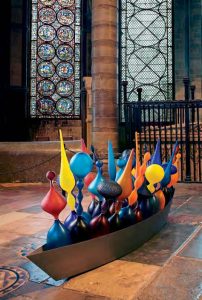 “In choosing this title, we wished to convey the idea that our planet is a unitary living organism whose sky is without prejudice. Living as we do under this generous light equally dispersed throughout our world, we are unavoidably confronted by the bleak contrast it presents—the vast swaths of territory blighted and under siege and the ever-increasing flow of migrants and refugees whose plight this Cathedral community wishes to highlight, as it always has. Their fates, and frankly, ours too, lie increasingly in the balance. There must be a better way . . . . The intent of our exhibition is that people will seek and find the good and the positive.”
“In choosing this title, we wished to convey the idea that our planet is a unitary living organism whose sky is without prejudice. Living as we do under this generous light equally dispersed throughout our world, we are unavoidably confronted by the bleak contrast it presents—the vast swaths of territory blighted and under siege and the ever-increasing flow of migrants and refugees whose plight this Cathedral community wishes to highlight, as it always has. Their fates, and frankly, ours too, lie increasingly in the balance. There must be a better way . . . . The intent of our exhibition is that people will seek and find the good and the positive.”
The exhibition leads viewers throughout the Cathedral, where they will discover Philip and Monica’s beautiful and thought-provoking pieces, crafted of exquisite materials, located simply in meaningful sections of the church. The People’s Wall, located where the exhibition concludes, rejects our current political concept of a wall. Instead, a transparent glass “wall of inclusion,” contains a representation, in colorful, multishaped vessels, of displaced people from around the globe, thriving in the most creative of communities. “This is our paean to a better future,” write Philip and Monica.
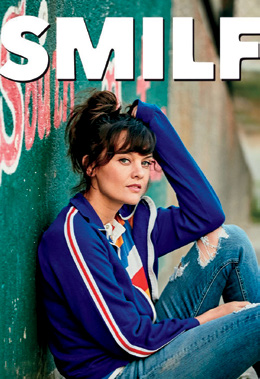
Frankie Shaw ’00
Actress and Showrunner, SMILF
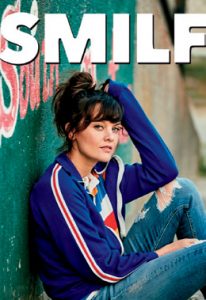
Frankie Shaw was nominated for a Golden Globe for Best Performance by an Actress in a Television Series Musical or Comedy, and her show SMILF was nominated for Best Television Series Musical or Comedy. She created the Showtime comedy series, which is based on the 2015 short film of the same name which she wrote, directed and starred in and which won the Short Film Jury Prize for Fiction at the 2015 Sundance Film Festival. Her struggles to work as an actor and be a single mother are the loose inspiration for SMILF. She serves as the series’ showrunner and, true to her feminist roots, each episode is directed by a woman.
In the show, her character, Bridgette Bird, is a smart, scrappy, young single mom trying to navigate life in South Boston with an extremely unconventional family. She struggles to make ends meet, which leads her to impulsive and at times immature decisions. Above all, Bridgette wants to make a better life for her son. SMILF takes on motherhood, co-parenting, and female sexuality through a raw and unfiltered lens.
Olivia Ames Hoblitzelle ’55
Author, Aging with Wisdom

Drawing on her own experiences as well as stories and studies about aging from other cultures, Olivia Ames Hoblitzelle explores the ways readers can nourish their inner lives and spirit even as their bodies age and faculties diminish. She offers guidelines in seven areas for being attentive to the gifts that grow more valuable with age: spiritual orientation, practice of silence, practice of mindfulness, practice of stopping, finding the sacred in the commonplace, meditation, and the practice of gratitude. She also shares the stories of six “wayshowers,” individuals whose stories illustrate aging with compassion. Olivia’s book invites inspiring reflections on finding beauty in aging, facing death with dignity, and rejoicing in earthly blessings.
Samuel Harrington ’69, MD
Author, At Peace: Choosing a Good Death After a Long Life
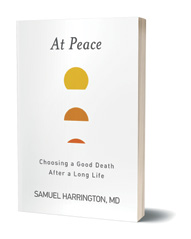 Most people say they would like to die quietly at home. But aggressive medical advice, coupled with an unrealistic sense of invincibility or overconfidence in our health care system, results in the majority of elderly patients dying in institutions. Many undergo painful procedures instead of the more peaceful death they deserve. At Peace outlines active and passive steps that older patients and their health care proxies can take to ensure loved ones live their last days comfortably at home and/or in hospice when further aggressive care is inappropriate.
Most people say they would like to die quietly at home. But aggressive medical advice, coupled with an unrealistic sense of invincibility or overconfidence in our health care system, results in the majority of elderly patients dying in institutions. Many undergo painful procedures instead of the more peaceful death they deserve. At Peace outlines active and passive steps that older patients and their health care proxies can take to ensure loved ones live their last days comfortably at home and/or in hospice when further aggressive care is inappropriate.
Informed by more than 30 years of clinical practice along with Dr. Samuel Harrington’s own experience with the aging and deaths of his parents, he describes the terminal patterns of the six most common chronic diseases; how to recognize a terminal diagnosis even when the doctor is not clear about it; how to have the hard conversation about end-of-life wishes; how to minimize painful treatments; when to seek hospice care; and how to deal with dementia and other special issues.
Beka Sturges ’90
Landscape Architect, The Clark Art Institute

The December 2016 issue of Landscape Architecture Magazine featured a 26-page spread on a project Beka Sturges completed at the Clark Art Institute, an art museum and research center in Williamstown, Massachusetts. An award-winning building expansion led to an opportunity for a new landscape design for the museum’s 140-acre site. Beka, an associate principal of Reed Hilderbrand, served as project landscape architect and manager for the project. Beka leads the firm’s office in New Haven. Always working to achieve spatial power by shaping the land, she aims to demonstrate the cultural and environmental value of landscape. Since opening the office in New Haven, she has also led projects for Yale and Brown Universities. According to the article, Beka “has made a study of Japanese architecture and culture, [and] likens it to the ‘hide and reveal’ of traditional Japanese design, which is incorporated into the site design and architecture at the Clark.”
Linda Carrick Thomas ’79
Author, Polonium in the Playhouse: The Manhattan Project’s Secret Chemistry Work in Dayton, Ohio
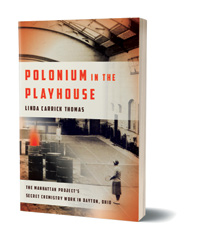 At the height of the race to build an atomic bomb, an indoor tennis court in one of the Midwest’s most affluent residential neighborhoods became a secret Manhattan Project laboratory. Polonium in the Playhouse presents the intriguing story of how this most unlikely site in Dayton became one of the most classified portions of the Manhattan Project.
At the height of the race to build an atomic bomb, an indoor tennis court in one of the Midwest’s most affluent residential neighborhoods became a secret Manhattan Project laboratory. Polonium in the Playhouse presents the intriguing story of how this most unlikely site in Dayton became one of the most classified portions of the Manhattan Project.
Weaving Manhattan Project history with the life and work of the scientist, industrial leader and singing showman Charles Allen Thomas, Polonium in the Playhouse offers a fascinating look at the vast and complicated program that changed world history and introduces the men and women who raced against time to build the initiator for the bomb.




